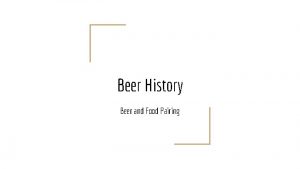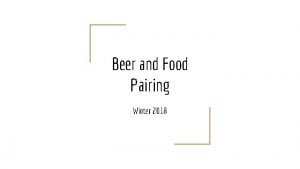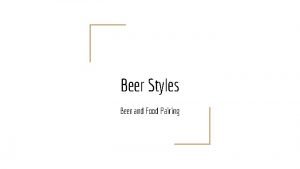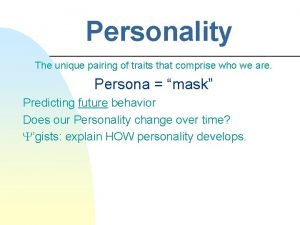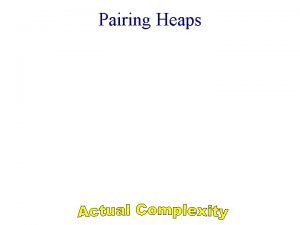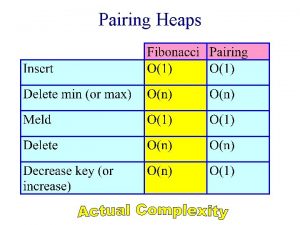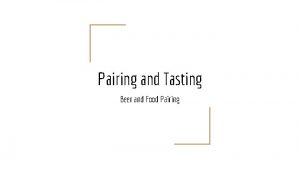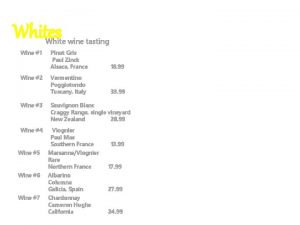Food and Wine Pairing FOOD AND WINE PAIRING







- Slides: 7

Food and Wine Pairing • FOOD AND WINE PAIRING IS SUBJECTIVE: Everyone has a different palate: – Germans say something is dry, we say it’s sweet. – People who eat spicy food experience wine differently from someone who eats pasta and potatoes • – – – • The TONGUE The tip senses sweetness = fruit, alcohol, sugar The front sides salt The back sides acid And very back bitter each section has buds of different intensities The NOSE Very sensitive in picking out minute differences in aroma Aromas are triggered by nose and brain connecting to memory The more senses you sense in a day the more you build up in memory bank – The palate is located at top of mouth close to throat, this area is sensitive and connects to the nasal cavity – AROMA is very important • What we perceive as tastes are really aromas: floral, fruits, nuts, vegetables, spice, herbs, roasted flavors, animal and alcohol are all aromas. – – – • – – THE SENSES Sweet, Bitter, Sour (Found in food and wine) Hot and Salty (come from food) 6 th sense UNAMI (found in food and wine) Unami: • • • – – “Delicious” or “Savory” Found in foods with high protein such as consumes, aged meats, shitaki mushrooms, dried seaweed, shellfish, raw seafood, soy sauce & tomatoes Amino acid: L-MSG (l-glutamate-monosodium glutamate) Related to spiritual sense: “feeling of perfect quality in a taste or some special emotional circumstance” Sweet and Unami are the only senses that are perceived as pleasant Can have adverse affects on wine, making wines more tannic, bitter or metallic tasting

Food and Wine Pairing History • Food and wine goes back centuries, in modern times it has become more trendy – – – • In 1928 Escoffer wrote that red meat and burgundy should be paired, as Champagne with entremets In 1931 Micheline Guide recommended wines with dishes 1939 a systematic approach by Pierre Andrieu paired wine with the evolution of the meal Old Systematic Approach: Red Wine with red Meat. White Wine with Fish. COMPARE • Find a balance; use the dominant flavors of a dish to match the wine • Weight of a wine should match the weight of a dish • If a dish uses a specific wine in the sauce use the same wine in the pairing • Foods with sweetness or acidity is paired w/ a wine of equal or higher sweetness or acidity – E. G. spaghetti & Barbera; Chicken in cream sauce & Chardonnay; Dulce de Leche & Sauternes • Focus on bridging ingredients of a dish such as berries, mushrooms, citrus etc… and use a wine that pairs with those same ingredients • Salmon with butter sauce with higher acidic Pinot Noir • Sour or acidic dishes are paired with a sweeter wine • Foods with richness are paired w/ acidic wines to cut through. • Intensity in flavors can provide a good contrast. E. g. An intense Alsace Riesling contrasted with a rich fatty roasted goose work very well Systematic Method (Course wine) *Dry before Sweet White before Red Young before Old Simple before complex Light before Heavy * Exceptions: Foie gras with Sauternes • • • Modern approach is a Lateral Approach with wine-dish combinations regardless of sequence. Today there are so many subtle foods and cuisines where matching food and wine takes more into consideration. Use an intermezzo or water as a palate cleanser when there is a change in coursing CONTRAST COMPLETE • Food and wine enhance each other. Such as salty prosciutto with melon • Use wine as a condiment for the dish being eaten. • Fish or seafood with acidic wine if you like lemon and butter sauce • Lobster with a buttery chardonnay if you like your lobster with butter • Salty food with sweet wine • Salty food with Acidic wine • Spicy food with sweet wine

Important Wine Components Sweetness Acidity • • • Where does it come from? – Grapes = Tartaric, Malic and Citric Acids – Fermentation = Succinic, Lactic and Acetic Acids – Acidity comes from under ripeness; as sugars increase acidity decreases. The key is to get to a point where acidity and sugars are in balance Acidity gives wine it’s shine or brilliance Influences aromas Good acidity makes a wine food friendly Affects of Acidity – Has the opposite affect of sweetness (milk is a warm sweet feel; tea w/ lemon is fresh clean feel) – Penetrates richness of ingredients & sauce (butter/Cream) to refresh palate – Mirrors tart items (Vinegar, lemon, tomato & chutney) – Mitigates oiliness, pizza, sautéed, deep fried – Brings out flavor in food Changes in Acidity Levels raises concerns – Modern winemaking and commercialism of wine has started to produce wines of lower acidity & big fruit. Wines are not food friendly & are more suitable to being drunk on their own. – The healthy culture of wine being a normal mealtime component is more & more eroded – Leading to more consumption of wine on own. Can be said that it is more suitable to a culture concerned with alcohol consumption than with the dining experience. – Critics and Press are big culprits. Robert Parker is partial to fruit bombs and non-acidity – The DANGER: soon we won’t be able to tell the difference between a wine from Spain, Italy, France or California. – Modern winemaking is based on trends…unfortunately the trends don’t last forever, and not always the best in quality. • Wines are classified into different categories of sweetness: – DRY: no detectable sweetness – OFF DRY: White Zinfandel – MEDIUM DRY: German Kabinett – MEDIUM SWEET: Vouvray – SWEET: Trockenbeerenauslese & Sauternes • Sweetness comes from residual sugar, left after fermentation has been stopped and from acidity levels – Low acid wines can seem sweeter than they really are – High acid wines mask the sugar levels Fruity Character gives impression of sweetness, but it is fruit sweetness not sugar sweetness; as a result of ripe grapes giving illusion of sweetness Affects of Sweetness – Takes the edge off hot foods – Matches well with slightly sweet condiments such as chutneys – Good contrast to salty flavors such as Asian foods – Very sweet wines work well with salty cheeses, Roquefort • • Bitterness • • • Bitterness adds balance, character and appealing flavors to wine Not Present in White Wines Is a result of high tannin levels especially green tannins associated with under-ripe grapes – Can come from aggressive pressing of grapes, fermentation choices, types of oak & aging • Affects of Bitterness – – – Oak and Alcohol • • • High alcoholic wines can give off tastes to food Alcohol is a sweet liquid; wines w/ high alcohol have a hint of sweetness Alcohol can also influence weight and body, the higher the alcohol the more body Oak and Alcohol creates richness & intensity due to oak treatment, fermentation and aging Affects of Alcohol and Oak – Alcohol accentuates heat and salt – Oak wines match well with similar flavors (nuts, toast, smoke & Caramel) – Roundness and Richness should match with similar textured foods – Rich meats, fish & Chicken w/ cream= full bodied chardonnays, light foods will be overpowered by wines of weight and richness Bitterness can make sweet foods bitter Pair with like flavored foods: grilled, charred, blackened Pair with bitter foods: broccoli, arugula, eggplant & bell peppers Saltiness • • • Saltiness is a craving component of taste We salt our savory foods, foods w/ Unami…work with wines w/ Unami Saltiness cuts and accentuates sweetness Wine doesn’t have salt but has affects on Salty foods Affect of Salty Foods – Acidity in wine cuts saltiness in food. Champagne & whites work with salty dishes, seafood: better than less tart reds – Salt will accentuate the tannins in a wine – Salt accentuates the alcohol in wine – Moderately sweet wines pair well with salty foods

Tips In Pairing WHAT IF THE FOOD IS: • Acidic: A dish with citrus or vinegar should be paired with a acidic wine. – Duck with oranges needs a more acidic red wine than Duck with olives • Salty: dishes with saltiness, such as soy sauce or seaweed will make wines with tannins more tannic and bitter. • Sweet: If the food is sweeter than wine then the wine will taste thin and tart. – Ice cream is almost impossible to pair. • • Highly Seasoned or Spicy: These foods can fatigue and numb the palate and the wine can get lost. – Wines with low tannins and low alcohol levels are best – Sweet wines contrast well Rich and Fatty Foods: Foods with cream sauces, fatty steaks or rich fowl – full bodied wines such as Chardonnay, Cabernet, Zinfandel, Merlot or Syrah are recommended SYNERGY: neither a wine nor food should overpower the other • Base Ingredients are the main portion of the dish (the Protein) • Bridge Ingredients are those extras on a dish that add to the flavor such as mushrooms, berries, beans and herbs such as ginger, tarragon, cinnamon, cloves • Cooking Method – Grilling, Roasting, Sautéing and braising are preferred methods to pair with wine – poaching, Steaming or smoking limit the wine choices • Easy Matches: Risotto and Chicken • Difficult Matches: Asparagus, Artichokes, Strong Cheeses – Chiles numb palate – Eggs Mask wine flavors too much Unami – Vinegar and Pickled foods can rob tastes and make wines more astringent • However balsamic and pickled ginger work well MARRIAGES MADE IN HEAVEN “the marriages between two exceptional beings are as rare in gastronomy as they are in life. ” Marc Meneau ‘Larousse des Vins et Vignobles de France’ Oysters and Chablis Roquefort and Sauternes Sole and Burgundy Caviar and Champagne Roast Lamb and Bordeaux Stilton and Vintage Port Goat Cheese and Sancerre BBQ Ribs and Zinfandel Stewed or Game Casseroles and Barolo

Cooking Methods Wine Choices Notes Poaching or Steaming Light white wine: Chenin Blanc or Pinot Grigio. Light fruity red: Beaujolaise or Grenache rose Use lighter weight wine, with non tannin, non acidic and less intense flavors Frying Chardonnay, Riesling or Pinot Noir Best is a wine with some acidity to contrast with the oils Grilling Whites Chardonnay, Full bodied White Rhone. Reds Pinot, Zin, Merlot, Cab. W/ Beef Barolo or Syrah from Rhone Adds flavor; works well with fruity oaky reds; Grilled beef needs tannic wines BBQ Roses; Zinfandel, Merlots or New world Tempranillos BBQ Sauce adds sweetness; less tannic reds Marinades New Zealand Sauvignon Blanc, Chablis or Fruity Grenaches or Tempranillos Marinades usually have strong flavors and require wines with bold flavors Roasting Oaky Chardonnays, Rhone blends or Gerwurtztraminers. Mourvedre, Syrah, Grenache, Nebbiolos Roasting can be complex. Herbs and spices will determine white or red. Rosemary and Thyme = reds Reduction Sauces Chardonnays and Rieslings Cabernets and Syrahs If has powerful flavor need intense wine; Drink w/ wine sauce is made with Braising and Stews Pinot Noir, Cabernets, Merlots Use the wine used in the stock Red Wine Sauce Sangiovese, Cabernets, Pinot Noir Use the wine sauce is made of Stews w/ beer or stout Merlot, Beaujolaise, Red Burgundies Use low tannin reds so not to overpower the beer flavor

FOOD TYPES Sparkling Wine Sweet Food No Effect, with chocolate can make wine taste bitter (Desserts, Chocolate Sweet Sauces) Sour Foods (Citrus, Vinegar, Pickles & Worchester) Salty Foods (Feta, Soy Sauce & Seaweed) Umami Foods (Beef, MSG & Shitake Mushrooms) Dry White Light Fruity Red Full Bodied Tannic Wine The wine will Makes wine taste dry if drier and more food is sweeter acetic than wine Increases Acidity Wine becomes more bitter and tannic Increases Sweetness Makes wine bitter If has more acid than wine then wine will taste sweeter No effect Reduces tannins Wine becomes sweeter Wine will taste sour Makes wine sweeter No effect Reduces Tannins Can become metallic Wine gets lost Can make wine taste metallic Can make wines more tannic and bitter A wine with equal to more unami is good; if it has less could taste tannic

SWEET WHITE ACIDIC WHITE SALT LEMON PROTEIN FRUITY RED ACIDIC RED SPICE APPLE/SUGAR CHOCOLATE
